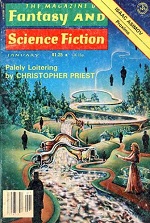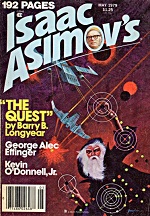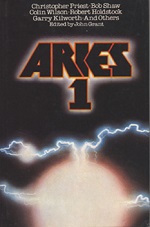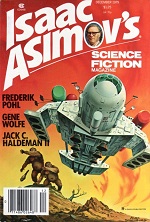|  
 | | | |  | | “Palely Loitering”
by Christopher Priest
First publication: The Magazine of Fantasy and Science Fiction, Jan 1979

At age ten, Mykle jumps off the time-flux bridge at a sharp angle and goes far into the future where he sees a lovely girl named Estyll, and as he grows older, he is drawn to the future and to her over and over again. One of these traversed the Channel at an angle of exactly ninety degrees, and to walk across it was no different from crossing any bridge across any ordinary river. One of these traversed the Channel at an angle of exactly ninety degrees, and to walk across it was no different from crossing any bridge across any ordinary river.
 One bridge was built slightly obtuse of the right-angle, and to cross it was to climb the temporal gradient of the flux-field; when one emerged on the other side of the Channel, twenty-four hours had elapsed. One bridge was built slightly obtuse of the right-angle, and to cross it was to climb the temporal gradient of the flux-field; when one emerged on the other side of the Channel, twenty-four hours had elapsed.
 The third bridge was built slightly acute of the right-angle, and to cross to the other side was to walk twenty-four hours into the past. Yesterday, Today and Tomorrow existed on the far side of the Flux Channel, and one could walk at will among them. The third bridge was built slightly acute of the right-angle, and to cross to the other side was to walk twenty-four hours into the past. Yesterday, Today and Tomorrow existed on the far side of the Flux Channel, and one could walk at will among them. 
| |
| | | | |

 
 
 
 | | | |  | | “The Dead of Winter”
by Kevin O'Donnell, Jr.
First publication: Asimov’s Science Fiction, May 1979

Four miners, trapped over winter in a mountain cabin, run out of food, but three people in a love triangle show up from the future with a couple of candy bars, a flask of drink, and a fued. “Oh, well—” He runs his pasty white hands through hispockets while Cole and the girl do the same. “I have a candy bar or two, I believe,” and he brings them out. “Cole, you have a bottle, don’t you?" “Oh, well—” He runs his pasty white hands through hispockets while Cole and the girl do the same. “I have a candy bar or two, I believe,” and he brings them out. “Cole, you have a bottle, don’t you?"
 The guy with the black hat scowls at him, but brings a flask out of his hip pocket and lays it on the table. The guy with the black hat scowls at him, but brings a flask out of his hip pocket and lays it on the table. 
| |
| | | | |

 
 | | | |  | | “The Agent”
by Christopher Priest with David Redd
First publication: Aries 1, 28 Jun 1979

Egon Rettmer—citizen of neutral Silte, but an agent for the Nord-Deutschland in their war against the Masurians—uses time travel for his communiques and, as he realizes on the eve of the N-D invasion, there’s the potention to use it for more, maybe even to get a good start with that entrancing visitor, Heidi. She was behaving towards him, literally, as if he had been in two places at once . . . as if, this morning, he had met her and told her of the escape plans he had only half started to form a few minutes ago! She was behaving towards him, literally, as if he had been in two places at once . . . as if, this morning, he had met her and told her of the escape plans he had only half started to form a few minutes ago! 
| |
| | | | |

 
 
 
 
 
 
 
 
 
 
 
 
 | | | |  | | “Written in Sand”
by Robert Chilson
First publication: Asimov’s Science Fiction, Dec 1979

 Paul Enias travels from 21st century Egypt back to the third century where he becomes Pausanias, falls in love with the slave Taia, and takes advice from Appolonius about which of 750,000 available books to bury in clay jars for future Egyptians to discover. Paul Enias travels from 21st century Egypt back to the third century where he becomes Pausanias, falls in love with the slave Taia, and takes advice from Appolonius about which of 750,000 available books to bury in clay jars for future Egyptians to discover. Odd that the book-man should shrug off the value of books, but Pausanias had too much to do to ponder it, overseeing the copying, the shipping of the books up the Nile, the reorganization of his new estate, and of course there was taia, then a new—bride. Odd that the book-man should shrug off the value of books, but Pausanias had too much to do to ponder it, overseeing the copying, the shipping of the books up the Nile, the reorganization of his new estate, and of course there was taia, then a new—bride. 
| |
| | | | |

No Time Travel. Move along. |
“Time Shards” by Gregory Benford, Universe Anthology #9, 1979 [recordings from the past ]

“Back to Byzantium” by Mark J. McGarry, Asimov’s, Feb 1979 [ancestral memory ]

Dragonriders of Pern #6 (Harper Hall #3): Dragondrums by Anne McCaffrey, Mar 1979 [no time travel ]

“Illusions” by Tony Sarowitz and Paul David Novitski, Asimov’s, Jun 1979 [just trust me:  ] ]

“The Thaw” by Tanith Lee, Asimov’s, Jun 1979 [long sleep ]

| |     |